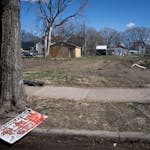Minneapolis police officers will be trained to exhaust all reasonable means in defusing potentially violent encounters before resorting to force, under new department rules unveiled Monday.
The guideline changes, which have been in the works since the release of a wide-ranging report by a presidential task force on policing last spring, are designed to mend broken public trust in the wake of high-profile police shootings of unarmed black men, department officials said.
Police Chief Janeé Harteau and Mayor Betsy Hodges unveiled the changes at a Monday news conference, pointing them out as one of many recent initiatives aimed at restoring the public trust — which is necessary to maintain public safety. The chief said it was "unacceptable" that there has never been a time when police relationships with communities of color have been without tension.
"Improved training is only the first step in repairing those ties," she said.
The changes, made late last month, largely focus on "sanctity of life." With that comes de-escalation of dangerous situations. The practice was encouraged in the past, but was never a requirement.
As part of the training, officers have been taught to consider what factors may contribute to a lack of compliance, such as language barriers, drug and alcohol use, or a mental crisis. The policy also urges officers to announce their intent to use force before actually doing so.
The current class of 32 police recruits will be the first to receive the new de-escalation training, department officials said. Other changes include the requirement for officers to intervene if they witness improper use of force by their colleagues, and to report it to their supervisor and internal affairs.
The policy changes drew immediate praise from the American Civil Liberties Union of Minnesota. The organization, which has been critical of the department's tactics, also called on other local law enforcement agencies, including St. Paul police, to institute similar measures to help reduce deaths and injuries in police-public encounters.
"Valuing human life and prioritizing de-escalation could decrease negative and potentially fatal interactions with the public," Executive Director Chuck Samuelson said. "We hope that all of the officers take these directives to heart and we begin to see a shift of officer behavior."
But former Minneapolis police Sgt. Jeffrey Jindra, who spent 10 years training officers, said the new guidelines may be out of touch with the realities of street policing. Similar directives had been handed down by the department in the past, he contended.
Given the mounting scrutiny that police face today, "cops are just not charging into calls right now," he said. "You could second-guess somebody during any situation. This kind of codifies that."
Officials would not say specifically how officers who violated the new policy would be disciplined.
Compliance with the new policy will monitored by the newly formed position of quality assurance commander.
Hodges said that since the chief's appointment in 2012, Harteau has tried to change the culture of a department that had become estranged from some of the communities it serves. Harteau said that the vast majority of police-public interactions end peacefully, but she acknowledged that "there've been instances of excessive force" in Minneapolis and elsewhere.
"We cannot have public safety without public trust," she said.
Most of the 850 or so officers on the force have undergone so-called "implicit bias" training aimed at helping them recognize unconscious prejudices in their decisionmaking.
And, by the end of the month, cops in three of the city's five police precincts will have been outfitted with body cameras. The rest of the force will get the devices by mid-October, officials said.
The department also overhauled its early intervention system, designed to identify potentially troubled officers and get them the help they need, in response to the recommendations of the U.S. Justice Department's Office of Community Oriented Policing Services.
Harteau said the revised guidelines were based on recommendations made within the past few years by the Washington D.C.-based think tank, the Police Executive Research Forum and President Obama's task force on 21st-century policing, which came response to a series of high-profile citizen deaths at the hands of police across the country.
The announced changes were already in the works last November, when 24-year-old Jamar Clark was fatally shot during a scuffle with two Minneapolis police officers, department officials said.
The killing drew international headlines and touched off weeks of protest. Earlier this year, both of the officers involved in the incident were cleared of wrongdoing in the shooting, a decision that was met with further outcry. Critics have argued that had the officers tried to de-escalate the situation instead of bringing Clark to the ground with a controversial takedown move, the killing may have been averted.
But department officials insist that officers in Minneapolis, as in other places, were already being taught to better balance use of force to help resolve confrontations with the public peacefully.
Using more scenario-based training, recruits were taught to back away from potential threats if necessary, while using their surroundings as cover, giving them time to reassess the situation and help them make the best decision.
"I expect officers to go home safe at the end of the day, but I want everyone to go home safe," Harteau said. "I'm not asking officers to put themselves in harm's way any more than they already are."
Libor Jany • 612-673-4064






